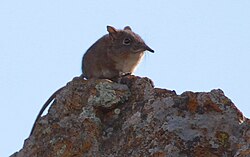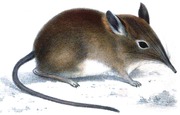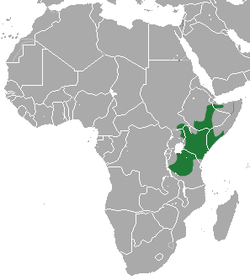Top Qs
Timeline
Chat
Perspective
List of macroscelids
Species in mammal order Macroscelidea From Wikipedia, the free encyclopedia
Remove ads
Macroscelidea is an order of small mammals. Members of this order are called macroscelids, or elephant shrews. They are exclusively found in Africa, in a variety of biomes from forests to deserts. They range in size from the Etendeka round-eared sengi, at 8 cm (3 in) plus a 8 cm (3 in) tail, to the grey-faced sengi, at 32 cm (13 in) plus a 26 cm (10 in) tail, and generally eat insects, other invertebrates, and plants. The only macroscelid species with an International Union for Conservation of Nature (IUCN) population estimate is the golden-rumped elephant shrew, listed as endangered with a population of around 13,000.

The nineteen extant species of Macroscelidea are grouped into a single family, Macroscelididae, and are split between six genera. Dozens of extinct macroscelid species have been discovered, though due to ongoing research and discoveries the exact number and categorization is not fixed.[1]
Remove ads
Conventions
The author citation for the species or genus is given after the scientific name; parentheses around the author citation indicate that this was not the original taxonomic placement. Conservation status codes listed follow the IUCN Red List of Threatened Species. Range maps are provided wherever possible; if a range map is not available, a description of the macroscelid's range is provided. Ranges are based on the IUCN Red List for that species unless otherwise noted. All extinct species or subspecies listed alongside extant species went extinct after 1500 CE, and are indicated by a dagger symbol "†".
Remove ads
Classification
The order Macroscelidea consists of a single family, Macroscelididae, which contains twenty species divided into six genera. Many of these species are further subdivided into subspecies. This does not include hybrid species or extinct prehistoric species.[2]
Family Macroscelididae
- Genus Elephantulus (round-eared elephant shrews): eight species
- Genus Galegeeska (Horn of Africa elephant shrews): two species
- Genus Macroscelides (long-eared elephant shrews): three species
- Genus Petrodromus (four-toed elephant shrew): one species
- Genus Petrosaltator (North African elephant shrew): one species
- Genus Rhynchocyon (checkered elephant shrews): four species
Remove ads
Macroscelids
Summarize
Perspective
The following classification is based on the taxonomy described by Mammal Species of the World (2005), with augmentation by generally accepted proposals made since using molecular phylogenetic analysis.[3]
Remove ads
References
Sources
Wikiwand - on
Seamless Wikipedia browsing. On steroids.
Remove ads

































